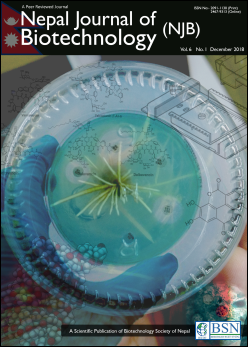Comparative Antioxidant, Antimicrobial and Phytochemical Assesments of Leaves of Desmostachya bipinnata L. Stapf, Hordeum vulgare L. and Drepanostachyum falcatum (Nees) Keng f.
DOI:
https://doi.org/10.3126/njb.v6i1.22331Keywords:
Antimicrobial, Antioxidant, Desmostachya bipinnata L. Stapf, Drepanostachyum falcatum (Nees) Keng f., Phytochemical screening, Hordeum vulgareAbstract
Nepal is rich in varieties of religious plants. The locally used religious plants also carry medicinal importance. Desmostachya bipinnata L. Stapf, Hordeum vulgare L. and Drepanostachyum falcatum (Nees) Keng f. are three plants belonging to the family Poaceae having religious significance in different practices of Hinduism. They were also used as traditional medicines by our ancestors but nowadays they are underutilized. In this research, our core objective was to validate the traditional assumption of use of these plants in medicinal purposes by carrying out the assessments like antimicrobial assessment, antioxidative assessment and phytochemical assessment. Methanolic extracts produced from leaves of all three plants were examined for antimicrobial activities through agar well diffusion method. The same extracts were also assessed for determining their antioxidative potentials with the use of DPPH (1, 1-diphenyl-2-picryl hydrazyl) free radical scavenging assay followed by qualitative phytochemical analysis and GCMS (Gas Chromatography Mass Spectroscopy). Most promising antimicrobial activity was shown by Desmostachya bipinnata L. against Salmonella typhimurium and Staphylococcus aureus, Drepanostachyum falcatum (Nees) Keng f. against Salmonella typhimurium and Klebsiella pneumoniae and Hordeum vulgare L. against Salmonella typhmurium and Staphylococcus aureus. The antioxidant activity of the plant extracts were observed in descending order of Hordeum vulgare L.>Desmotachya bipinnata L. > Drepanostachyum falcatum (Nees) keng f. and phytochemical assessment of the extracts indicated the presence of alkaloids, glycosides, sterols, Triterpenes, Saponins, Flavonoids, Coumarins, Phlobatanin and reducing sugars. Through this project, we can clarify that the above mentioned plants have bioactive compounds which contributed for the presence of antimicrobial and antioxidative property in the plants.
Downloads
Downloads
Published
How to Cite
Issue
Section
License
Copyright Notice:
The manuscript submitted to NJB must be an original contribution, not previously published and should not be under consideration for publication elsewhere. When the manuscript is accepted for publication, the authors agree to automatically transfer the copyright of the article to the publisher. It should grant permission to any third party, in advance and in perpetuity, the right to use, reproduce or disseminate your article, according to the NJB copyright and license agreement.
Authors transfer copyright to the publisher as part of a journal publishing agreement but have the rights to: Share their article for Personal Use, Internal Institutional Use and Scholarly Sharing purposes, with the NJB applies the Creative Commons Attribution-NonCommercial CC BY-NC license to all the works we publish after Jun 2020 (Before it was CC BY-NC-ND). Under this license, authors agree to make articles legally available for reuse, without permission or fees, for virtually any non-commercial purpose. Anyone may remix, adapt, and build upon your work non-commercially, and although their new works must also acknowledge you and be non-commercial, they don’t have to license their derivative works on the same terms. More details on CC BY-NC refer to its Licence Deed and Legal Code.






